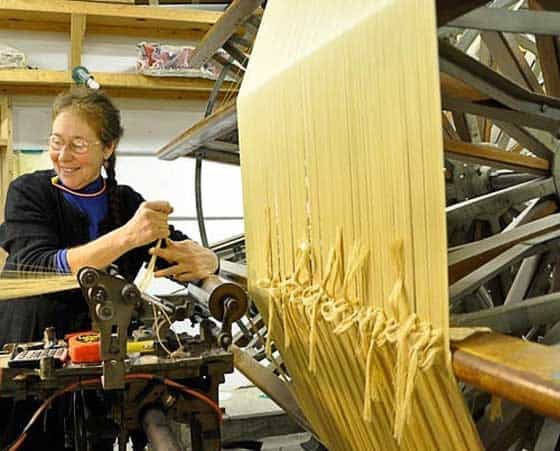
S. Rabbit Goody
I started weaving when I was in my late teens, without any real instruction – the first book I had was Sunset’s How to Weave book, but it came very naturally to me and my first real experiences were with Dee Ertel in her shop in Bennington, VT and then with Jane Keener and “Granny” at Mystic Seaport in Connecticut.
My curiosity and my interest in hand and early power technology was something that I developed throughout high school and college. The understanding of process – how things come into being – is the guiding question in all my work. My main academic interest is the transition from hand to powered technology in the textile industries.
I was a hand weaver making my living producing men’s scarves for the New York City and Boston stores during the 1970’s. I understood two very important things about hand weaving: First, no matter how good or fast I was, I could never make enough scarves to compete with machine made scarves, so I chose to weave only very exotic high-end cashmere and silk. The second thing that I recognized was that my body would not survive that type of work forever. I did fairly well in that business but my love of machinery and my understanding that the old shuttle looms could be made to produce what I wanted more efficiently led me to find mills that were going out of business and procure old commercial looms that would have been destroyed for the value of the iron.
I established the mill after working for many years at the Farmers’ Museum in Cooperstown, NY as the head of Domestic Arts and as Assistant Curator for Textiles. My husband refers to our weaving as “Heavy Metal Weaving.” We run all Crompton and Knowles equipment that dates back to the late 1890’s and as recent as the 1960’s. These looms as well as our coner, quiller and warper are all American-made industrial textile machinery. There are very few mills still running this type of loom in this country and there are no American companies still producing textile equipment.
The mill has been producing fabrics for over 32 years. We built a Morton building in 1991 and soon outgrew the space. We built an addition in 2001 and have filled that as well. I started out with just two co-workers and now we are a staff of seven.
Being able to combine several aspects of textiles is what makes my approach unique. I have spent a great deal of time studying historic textiles in museum collections because being a curator gave me access to many, many collections. I have studied weavers’ draft books and have learned to read the weavers’ recipes and receipts from the past so that I can recreate textiles that have not been seen for hundreds of years. My area of interest for historic textiles is the period between 1600 and 1870, a time when the textile industry went through changes from hand production to powered process in Europe and the United States. Woven coverlets and ingrain carpet are my most deeply researched textiles.
One of my dreams was to run a Jacquard loom and to be able to weave fabrics that were woven in the 18th and 19th centuries. Our Jacquard is a relatively small harness and can only produce limited designs for damask and ingrain carpet, but it is one of the most exciting parts of our work. We have reproduced a damask pattern drawn by Marguerite Garthwaite in 1751 that may never have been woven before. The watercolor is in the collection of the Victoria and Albert Museum in London.
In addition to historic patterns, I now design very modern textiles that look as if they were hand woven but are in fact woven on our power looms. These are primarily upholstery fabrics. We are able to make our looms do things that they were never designed to do partly because they are mechanical and not electronic. We are able to fabricate parts and to change them when necessary, giving us unheard of flexibility.
Address
7097 Sanborn Road
Loudon, New Hampshire 03307
